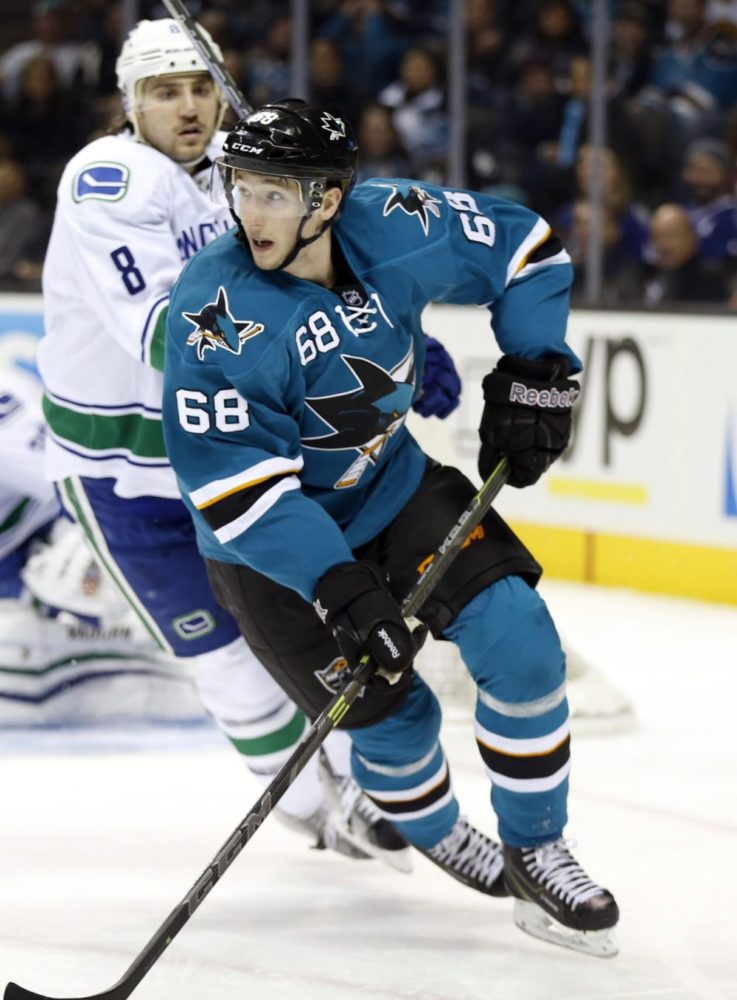When the puck dropped on opening night for the Sharks’ 2014-15 season, San Jose had a Nordic goalie but no Nordic skaters.
For Thursday’s game between the Washington Capitals and San Jose Sharks, a total of five Nordic skaters took the ice for the Sharks (the Nordic goalie departed in 2015).
What caused Sharks management to move in this direction?
Lather, Rinse, Repeat
For the Sharks, the Nordic door opened with the 2014 signing of Melker Karlsson. Karlsson was brought into the Sharks organization based on his success in Sweden. He was the top player on back-to-back championship teams in the top Swedish league. He started out with the AHL Worchester Sharks before being brought to San Jose mid-season in the 2014-15 campaign. Karlsson proved to be one of the brighter lights in an otherwise difficult season. He established himself quickly, developing a reputation as a ‘puck hunter’. Eventually, he worked his way to the Sharks’ top line, where he began to score net-front goals.

The success with Karlsson gave the Sharks plenty of reason to repeat the process. Next up was Joonas Donskoi. Donskoi was the playoff MVP for his championship team in the top Finnish league. He came to San Jose in the 2015 offseason and immediately established himself as an NHL-level player. For the second consecutive season, the Sharks’ top rookie was a Nordic import.
With the success of Donskoi and Karlsson, the Sharks went for more, signing Marcus Sorensen in May of 2016, then adding the NHL-proven Mikkel Boedker in July.
Lastly, the Sharks added veteran Jannik Hansen at the recent trade deadline. Hansen was effective in his Sharks debut against the Capitals.
Value At Bargain Prices
The total number of players and draft picks used to acquire these five players? Two. Melker Karlsson, Joonas Donskoi and Marcus Sorensen all came as free agents. Each was well into their professional career when they left Europe for San Jose. The two NHL veteran additions are from Denmark. Mikkel Boedker was a free agent signing and Jannik Hansen was acquired from Vancouver in a trade. Among this group, only Hansen required the Sharks to part with assets. Hansen cost the Sharks a draft pick and a prospect.
Common Features
All five players are wingers. None are large players, Hansen at 6’1” is the largest, while Boedker is the only one listed at 200 lbs or over. Sorensen and Karlsson are listed as the two lightest players on the team.

Doug Wilson, the Sharks’ general manager, has emphasized a speed game, that relies on smart anticipation and quick reactions. Players need efficient acceleration to cover short distances to get to the right spot. This is another quality common to these five players.
They each add chemistry to their lines. They skate in straight lines. Most are comfortable doing the dirty work despite their size. They all have solid puck skills. Even those earning third and fourth line paychecks would not look out-of-place on either of the top two lines. Boedker and Karlsson have played on both the top and bottom lines this season.
The players brought to the Sharks directly from Europe (Donskoi, Sorensen and Karlsson) were all mature players with well-developed games before they joined the Sharks organization. Players coming from Europe need to adjust to the North American style of play as well as the smaller rink size. But for these players, the core development work had already been done, considerably shortening the time needed to make adjustments. Sorensen and Karlsson made their NHL debuts at age 24, Donskoi at age 23.
About Depth
This group includes nearly half of the forwards San Jose started against Washington (5/12).

Of the five, only Boedker qualifies as a top-six talent, though perhaps Donskoi may join him at some point. But this Sharks team is no longer about the top line or even the top two lines. Balance has led the Sharks to their current record.
Entering the game against the Caps, their top line players (excluding the just-signed Hansen) were a combined plus-19. The second line plus-20. The third line plus-10 and the fourth line plus-7. Their bottom-six, perhaps for the first time in franchise history, provide San Jose a meaningful competitive advantage.
The answer to the question at the top of the article is straightforward. The Sharks tried a new approach when they acquired Melker Karlsson and it worked. The team found a quality NHL player for minimal acquisition cost. So they repeated the process. This process continues to work.
The Sharks are one of very few teams that can roll four lines without hesitation. Adding five Nordic forwards over the past few seasons is at the heart of their depth.
Zeke’s Notes
• A sixth Nordic player made his NHL debut for San Jose this season. Tim Heed, a 26 year-old defenseman, played in one game in January. Unless multiple injuries strike, it is unlikely he plays for the Sharks again this season.
• Perhaps some Hart Trophy voters skeptical of Brent Burns’ candidacy stayed up late for the marquee matchup against league-leading Washington Capitals. Burns delivered a tour de force performance. He was on the ice for all four Sharks goals, notching three assists against the Caps in a 4-2 win. If there was any remaining skepticism about Burns’ viability for the League’s most valuable player award, this game should end it.